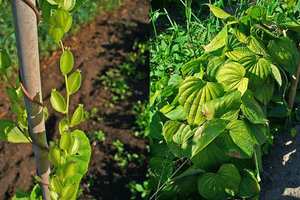
Pinyin: Shan Yao Latin: Dioscorea Villosa
Physical Characteristics
Wild Yam is a perennial Climber growing to 3m, hardy to zone 6 in flower from September to October. The Wild Yam flowers are dioecious (individual flowers are either male or female, but only one sex is to be found on any one plant so both male and female plants must be grown if seed is required) The plant is not self-fertile.
Wild Yam prefers light (sandy), medium (loamy) and heavy (clay) soils and requires well-drained soil. The plant prefers acid, neutral and basic (alkaline) soils and cannot grow in the shade, requires moist soil.
Family
Habitats
Woodland Garden; Sunny Edge; Cultivated Beds;
Edible Uses*
Edible Parts: Root.*
Tuber - cooked[177]. Some caution should be exercised with this plant.*
Traditional Chinese Medicinal (TCM) Uses:*
Wild yam roots, and the roots of many other members of the genus, contains diosgenin[222]. Diosgenin is widely used in modern medicine in order to manufacture progesterone and other steroid drugs. These are used as contraceptives and in the treatment of various disorders of the genitary organs as well as in a host of other diseases such as asthma and arthritis[222, 254].*
Wild yam roots are anti-inflammatory, antispasmodic, cholagogue, diaphoretic and vasodilator[165, 238]. They are also a visceral relaxant[165]. The Dioscorea Villosa plant affords one of the best and fastest cures for bilious colic, and is especially helpful in treating nausea of pregnant women[4] and has been used to ease the pain of childbirth[257].*
Wild Yam is also taken internally in the treatment of arthritis, irritable bowel syndrome, gastritis, gall bladder complaints, painful menstruation etc[238]. The root is harvested in the autumn and dried for later use[238]. Wild Yam root should not be stored for longer than 1 year, since it is likely to lose its medicinal virtues[4]. Caution is advised in the use of the this plant, when taken fresh it can cause vomiting and other side effects[222]. The root, harvested in September, is used to make a homeopathic remedy[232] the main use of which is in the treatment of infant colic[232].*
References
- [K] Ken Fern
- [1] F. Chittendon.RHS Dictionary of Plants plus Supplement. 1956 Oxford University Press 1951
- [4] Grieve.A Modern Herbal. Penguin 1984 ISBN 0-14-046-440-9
- [37] Thompson. B.The Gardener's Assistant. Blackie and Son. 1878
- [43] Fernald. M. L.Gray's Manual of Botany. American Book Co. 1950
- [165] Mills. S. Y.The Dictionary of Modern Herbalism.
- [174] Kariyone. T.Atlas of Medicinal Plants.
- [175] Bird. R. (Editor)Focus on Plants. Volume 5. (formerly 'Growing from seed') Thompson and Morgan. 1991
- [177] Kunkel. G.Plants for Human Consumption. Koeltz Scientific Books 1984 ISBN 3874292169
- [200] Huxley. A.The New RHS Dictionary of Gardening. 1992. MacMillan Press 1992 ISBN 0-333-47494-5
- [219] Grey-Wilson. C. & Matthews. V.Gardening on Walls Collins 1983 ISBN 0-00-219220-0
- [222] Foster. S. & Duke. J. A.A Field Guide to Medicinal Plants. Eastern and Central N. America. Houghton Mifflin Co. 1990 ISBN 0395467225
- [232] Castro. M.The Complete Homeopathy Handbook. Macmillan. London. 1990 ISBN 0-333-55581-3
- [235] Britton. N. L. Brown. A.An Illustrated Flora of the Northern United States and Canada Dover Publications. New York. 1970 ISBN 0-486-22642-5
- [238] Bown. D.Encyclopaedia of Herbs and their Uses. Dorling Kindersley, London. 1995 ISBN 0-7513-020-31
- [254] Chevallier. A.The Encyclopedia of Medicinal Plants Dorling Kindersley. London 1996 ISBN 9-780751-303148
- [257] Moerman. D.Native American Ethnobotany Timber Press. Oregon. 1998 ISBN 0-88192-453-9
- [270] Flora of N. America
Source: Dioscorea Villosa Plants For A Future, England 1996-2008.
This work is licensed under a Creative Commons License.
Natural dietary supplements are designed to offer the body support to promote health, harmony, balance and overall well being.*

 Get Well Natural, LLC
Get Well Natural, LLC  Kidney Function & Regeneration Health
Kidney Function & Regeneration Health  Platelet & Blood Cell Health
Platelet & Blood Cell Health  Prostate, Flow & Function Health
Prostate, Flow & Function Health  General Mind & Body Health
General Mind & Body Health  Heart, Cholesterol & Cardio Health
Heart, Cholesterol & Cardio Health  Allergy-Free Body
Allergy-Free Body  Anxiety & Stress
Anxiety & Stress  Blood Platelet Counts & Function
Blood Platelet Counts & Function  Blood Pressure Health
Blood Pressure Health  Kidney Function Health
Kidney Function Health  Immune System Health & Balance
Immune System Health & Balance  Prostate & Urinary Health Function
Prostate & Urinary Health Function  Blood Sugar Balance
Blood Sugar Balance  Cardiovascular Heart Health
Cardiovascular Heart Health  Detoxification & Healthy Cells
Detoxification & Healthy Cells  Women's Health
Women's Health  Liver Regeneration
Liver Regeneration  Pain-Free Body
Pain-Free Body  Water & Air Filtration
Water & Air Filtration 


